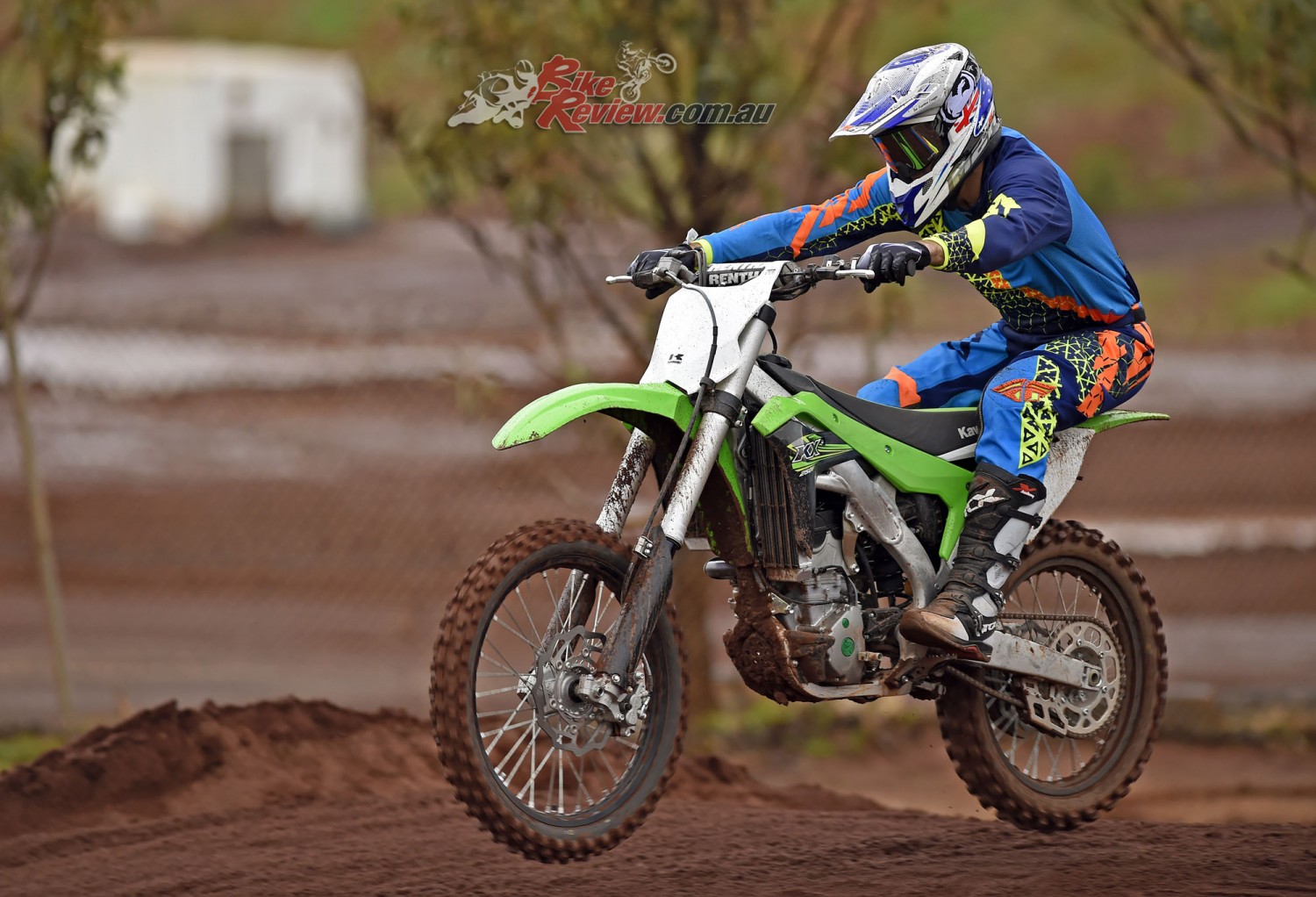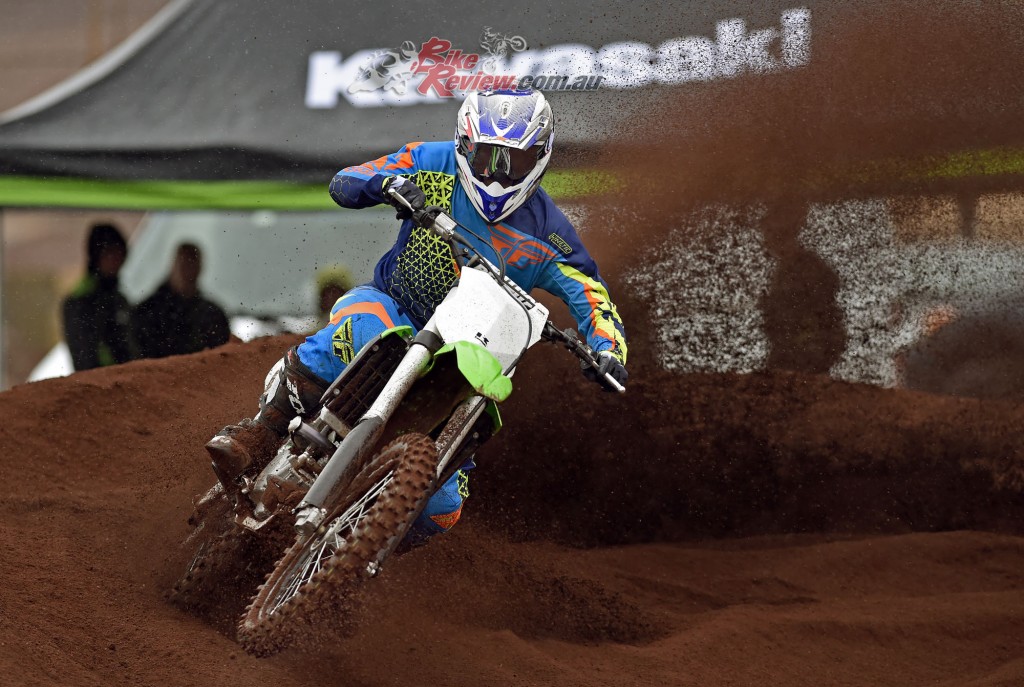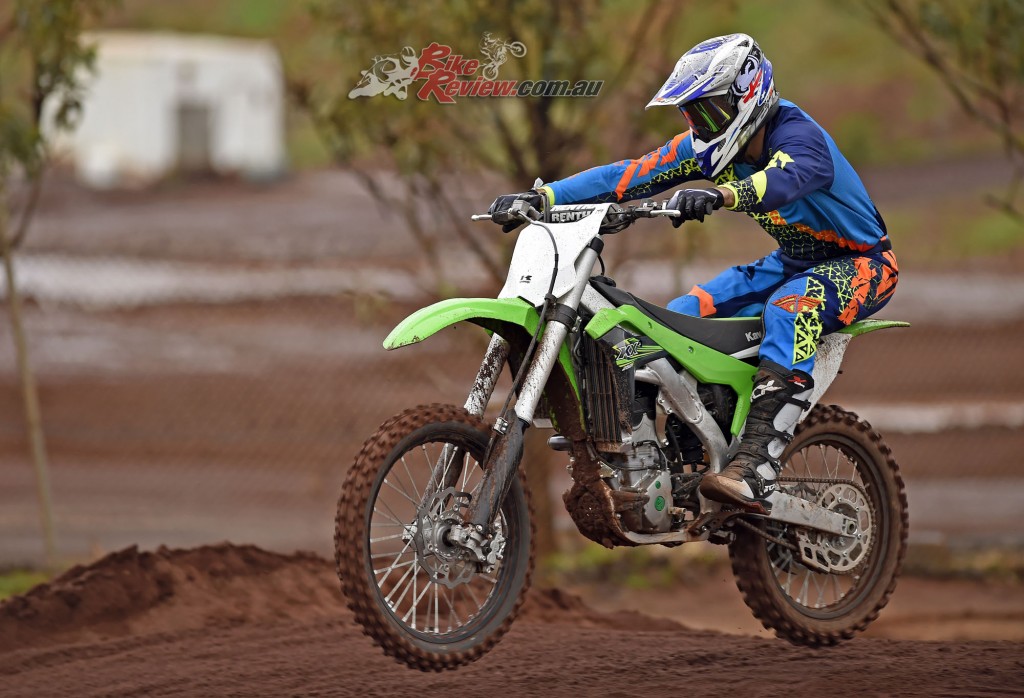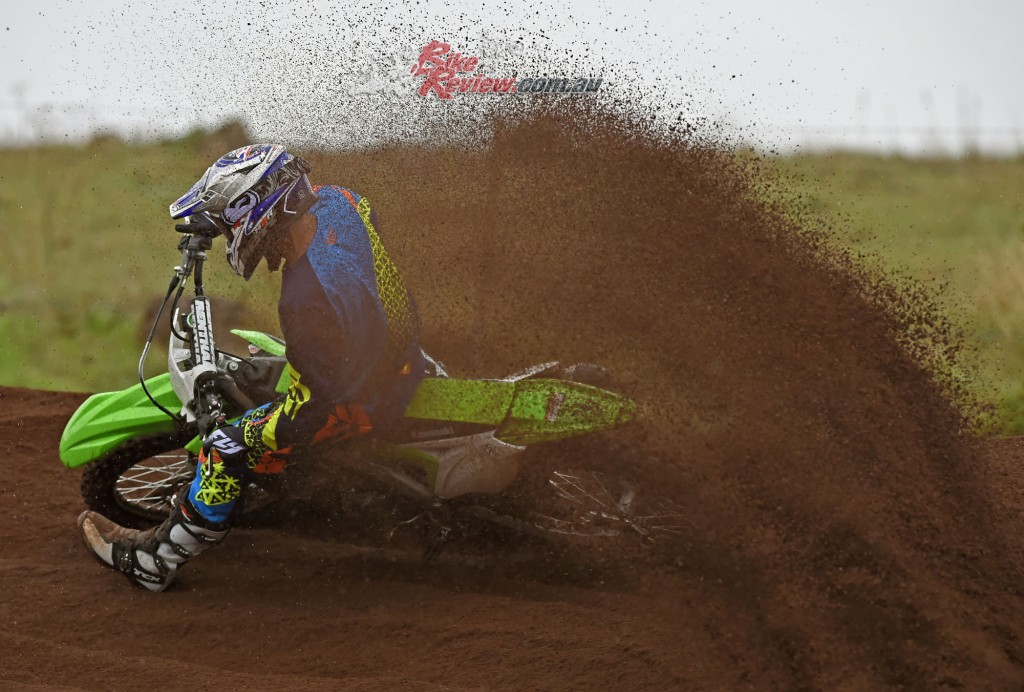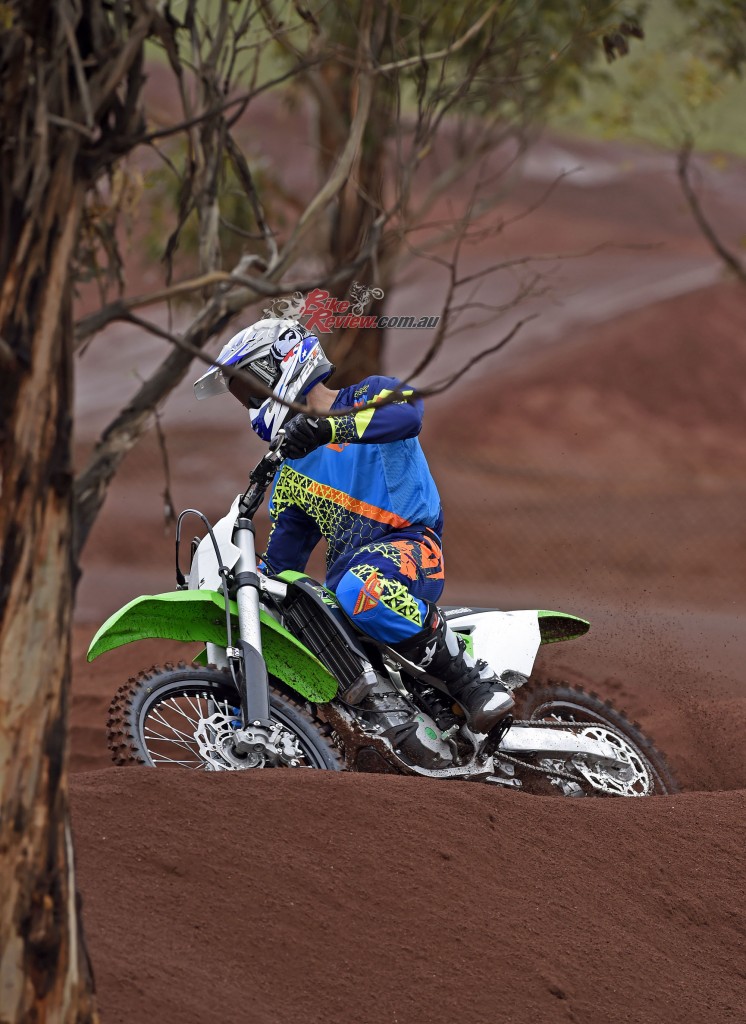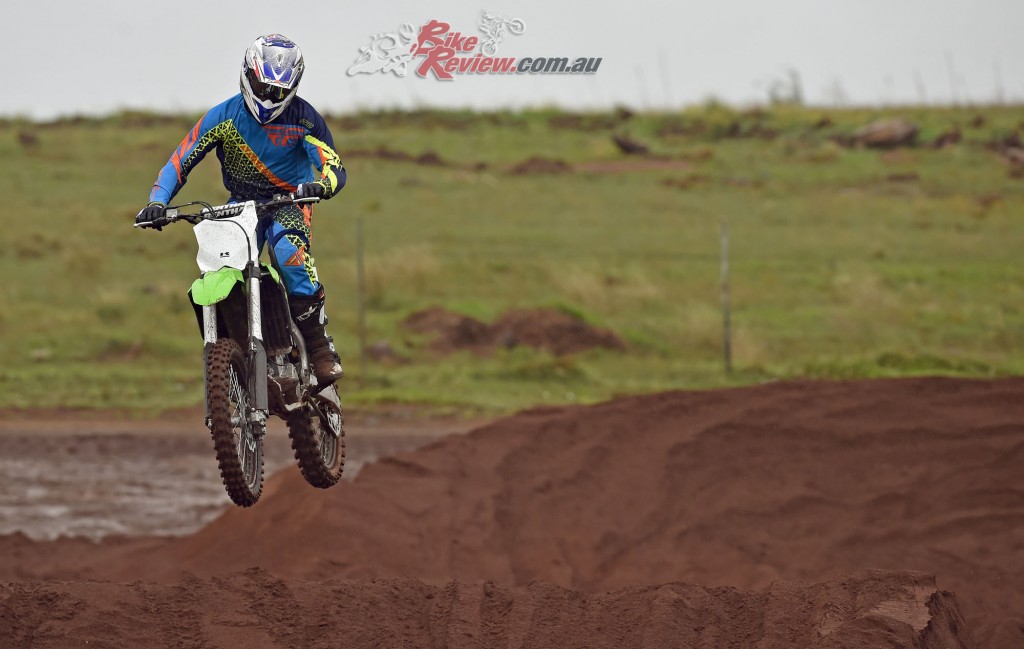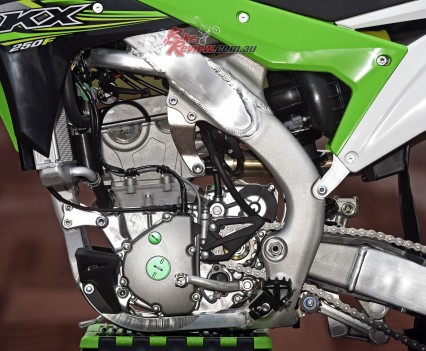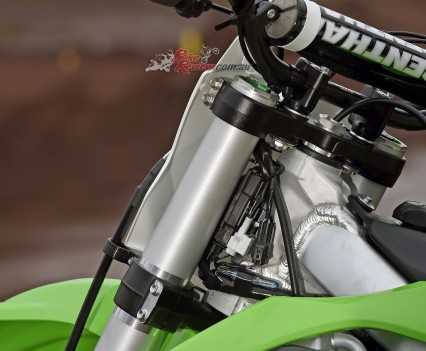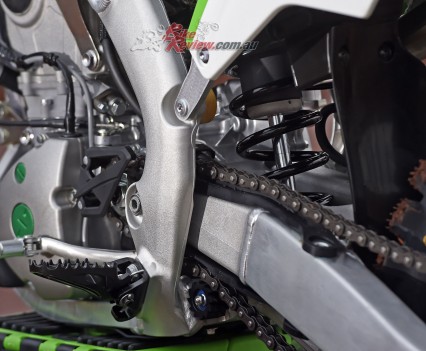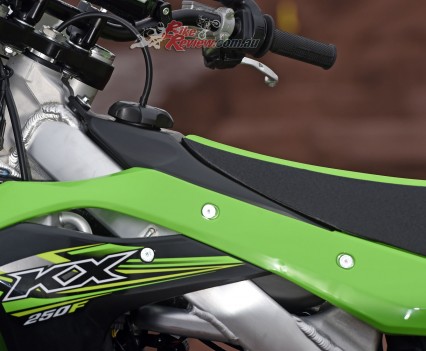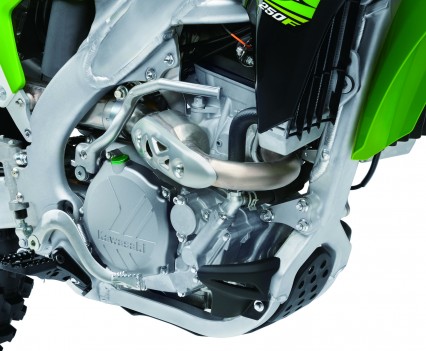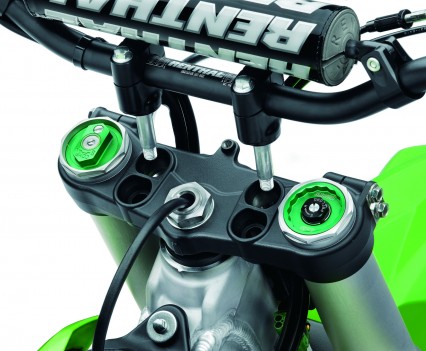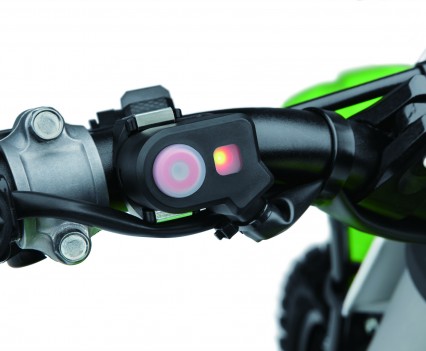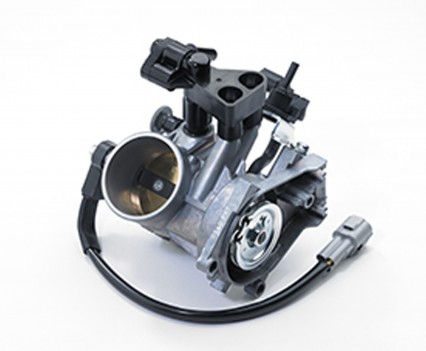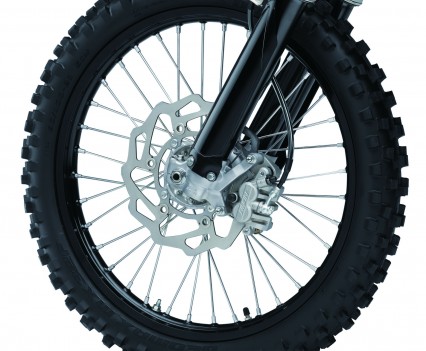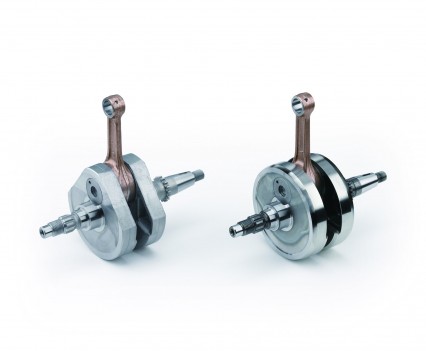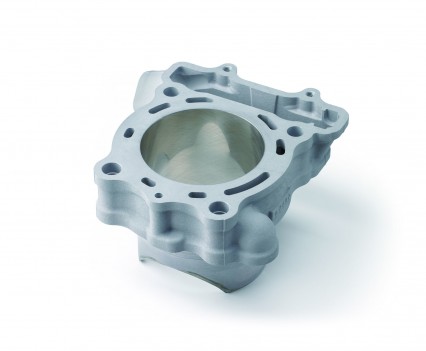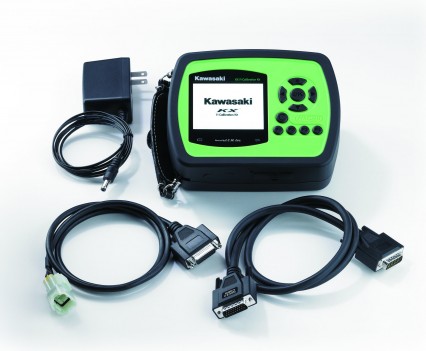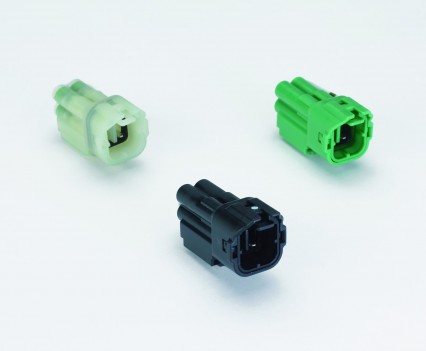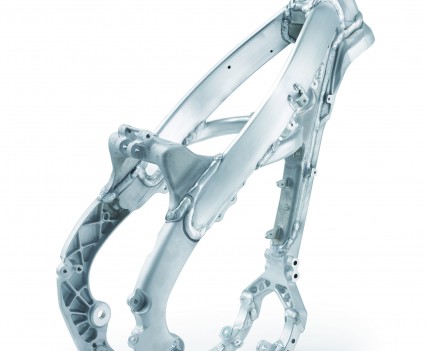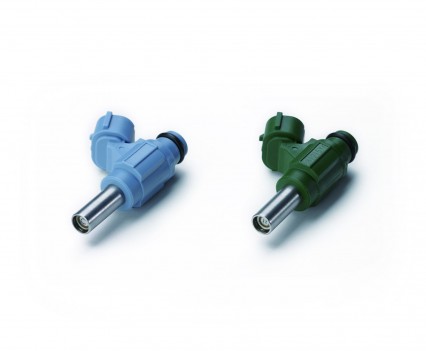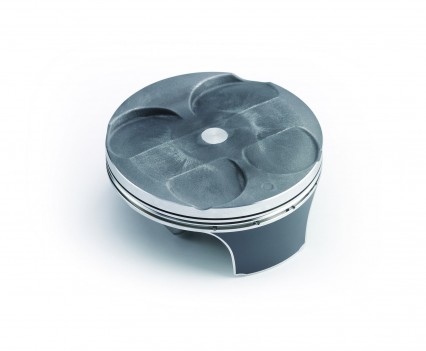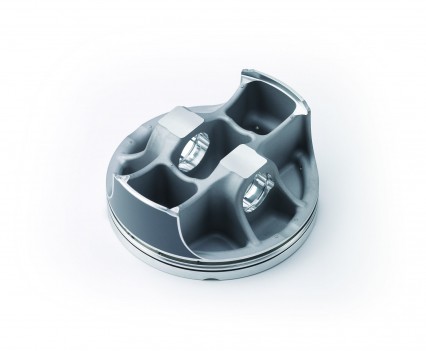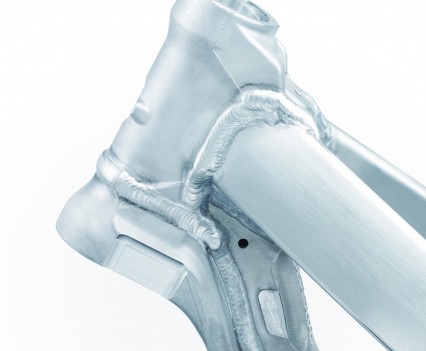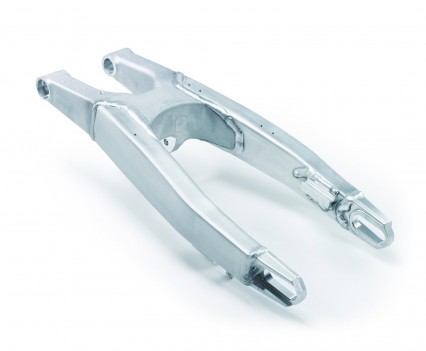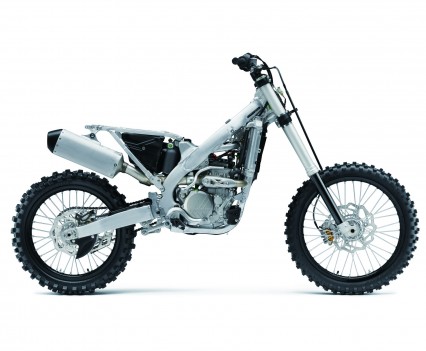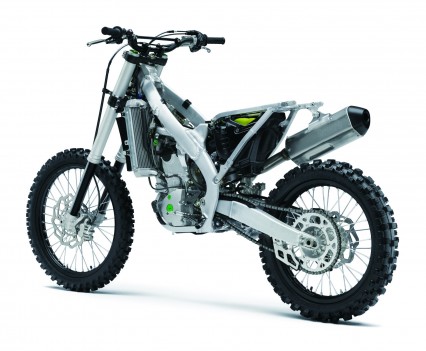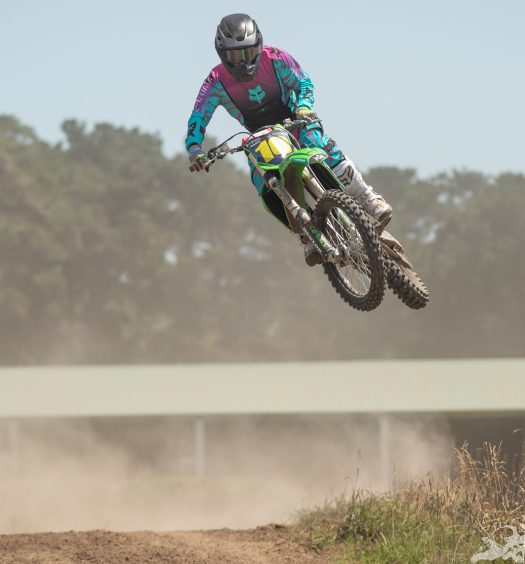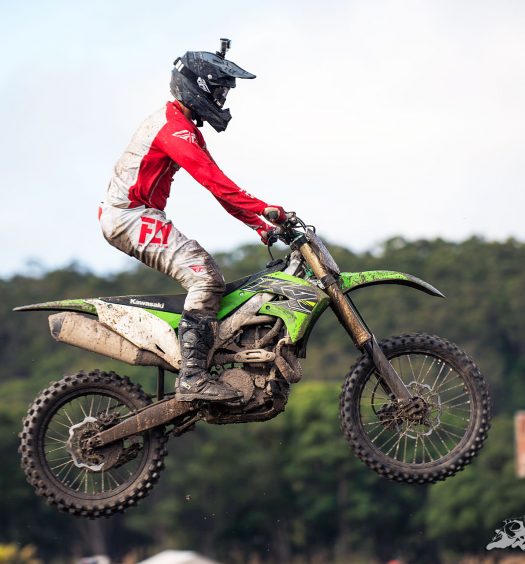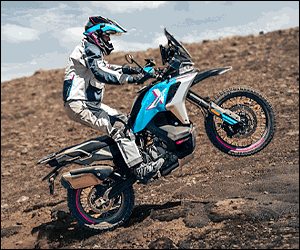Ben O'Brien heads to the Australian launch of the new 2017 Kawasaki KX250F, here's his review. Test by Ben O'Brien Images by Jeff Crowe
With the 2017 Kawasaki KX250F launch date set well in advance there was no possibility that anyone could have predicted the sheer amount of rain that would fall in the few days beforehand.
In fact there was so much rain that at about 8.30pm the night before it looked like testing would be impossibility as the track was underwater.
Arriving bright and early at Ride Park in Parwan Victoria expecting, well, nothing to ride on, we were met with a completely new test track… In the car park!
While relatively short, it consisted of a whoop section, nice sandy berms and a few nicely groomed jumps. Rob, the park’s, owner had been at it all night with no sleep. Hat’s off to both Kawasaki and Rob. Sterling effort.
Jumping on the KX250F the very first thing you notice is the width of the radiator shrouds. They are very narrow and do not interfere in any way when moving around on the ultra flat seat. This gives a very small feel overall. From the fuel filler cap to the rear guard there is zero to get caught up on and transitioning from standing to getting all your weight over the front is slick.
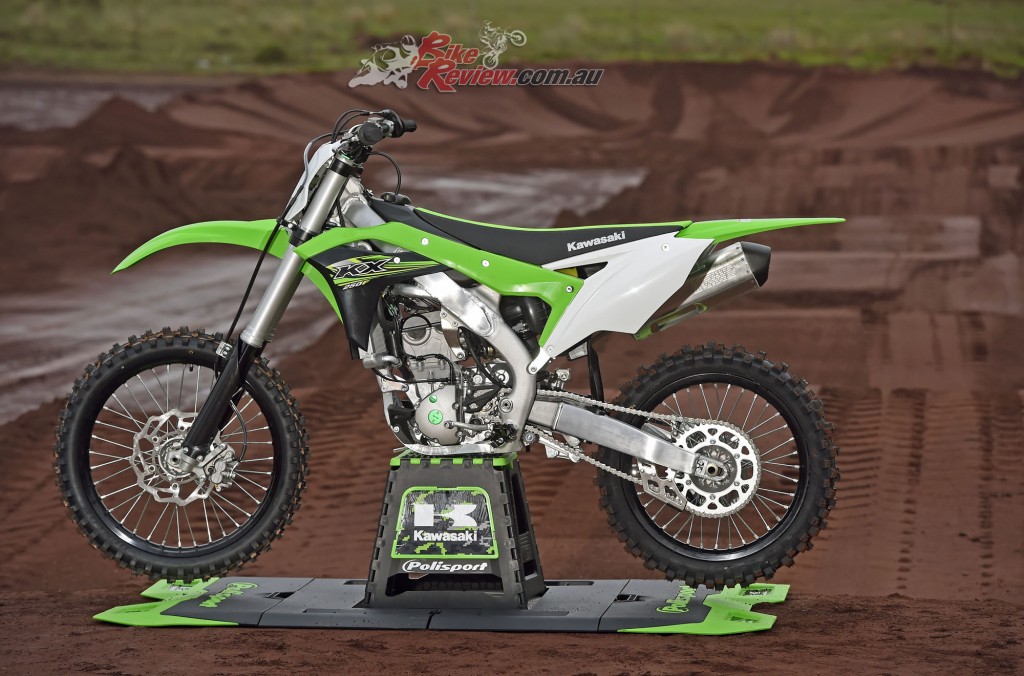 Suspension both front and rear I found to be exceptionally smooth.
Suspension both front and rear I found to be exceptionally smooth.
The forks gave no harsh spots or blowing through the stroke, even though there were no huge kickers or braking bumps to really challenge the suspension on this test track. Having a whoop section gave a good indication of suspension performance as it saved my butt on the occasions that I got it wrong.
Coming into a corner off throttle and under brakes the front end held high in the stroke and did not feel like folding, nor did the SSF show any signs of being unstable. I found that this was confidence inspiring and would love to push the suspension and chassis much harder under racing conditions in the future.
Coming away super impressed with the forks, the rear shock was exceptionally well behaved as well. Without gear I weigh in at 72kg. The standard race sag was left at 105mm and felt pretty spot on. I didn’t feel the need to make any adjustments to the shock but having both high and low speed compression adjustment will make fine tuning all the easier for owners.
The Showa suspension it just oozes quality and I feel confident that this setup will be a standout on any MX track.
Shod with the new Dunlop S3 tyre, in the soft loam the tyre was faultless and inspired confidence whether on edge or holding it pinned. Braking is taken care of by Nissin brakes both front and rear. Front end braking is extremely powerful and has fantastic feel, you can easily brake to the apex of the corner with confidence and intimate control in modulation. Rear brakes do the job but I did have trouble with pedal height, especially mid corner. It is probably just a product of the way in which I ride but I prefer the rear brake pedal lower and then hardly any free play. You can’t achieve this with the standard set up.
With oodles of go the Kawasaki likes to make most of its power in the mid to top rpm range, coming on very strong and continuing well into the overrev. The 2017 model makes a substantial amount more power and torque in the upper rev range than the 2016 model it has replaced without losing any of its bottom end, a feat not easily accomplished. I would say the KX250F engine characteristics are suited to a more aggressive rider who isn’t afraid to keep it on the boil. Get it right and you will be moving blindingly fast.
I will admit to losing momentum several times due to wrong gear selection in the soft loam, as short shifting the 250 isn’t it’s strong point, and gear selection needs to be on the money, however, gear changes are slick and without issue.
On the day I would have liked another tooth or two on the rear sprocket to punch out of the corner a little harder. In hindsight I should have changed the FI Coupler to the White Soft Terrain map. This may have alleviated my need for different gearing by making the power more aggressive off the bottom.
Throttle response from the dual injector setup is spot on as well. I found no flat spots and even if I snapped open in the wrong gear the bike would just build power rather than flame out or blubber. Snap the throttle in the meat of the power and the result is instant and clean. No popping on deceleration, indicating incorrect fuelling either, so good mapping by Kawasaki. Firing up the Kawasaki is easy and a one kick affair every time.
Being that I am super interested in motorcycle electronics, I was pretty keen on giving the launch control a good testing. After making many simulated starts with both the launch control activated and deactivated I genuinely think this is another great tool to have available. Starting in second and launch activated the power just has the edge taken off until you click third gear when it is deactivated automatically. Whilst I can’t be sure on the exact advantage I think that there would be a bike length in it come the first turn.
Hopefully we will have the opportunity to test the KX again later in the year on a standard MX track for a more detailed review on suspension and engine performance. A great job for the 2017 by Team Green.
TECH TALK
Often a new bike model is just BNG (Bold New Graphics) but Kawasaki must have missed the memo because the new 2017 KX250F is a Bold New Everything.
Kawasaki have redesigned and changed pretty much every part of the 2017 KX250F with the ultimate goal of keeping the 250 at the front come chequered flag time. During factory testing the 2017 model managed to lap 1.6s per lap quicker than the 2016 model, nothing to be sneezed at.
Just glancing over the bike it is easy to spot some key differences, especially to the ergonomics. Radiator shrouds are 20mm narrower thanks to the radiators being angled forward 10 degrees, it’s a simple idea but very effective in reducing width at the right spot. The tank junction and radiator shrouds are also perfectly matched, with a slight cut out up top for your leg to slide up next to the forks without getting snagged.
The new shrouds also continue all the way back to the rear side panel and air box, giving a seamless panel with no places to snag your boots and, with possibly one of the flattest seats of any MX’er and a fuel tank that is 20mm lower, the clean, snag free lines continue.
Stickers are now an in-mold design, which means no more peeling stickers while pressure washing after a muddy session.
Footpegs are adjustable to allow a drop of 5mm for either a taller rider or can also be used to change the centre of gravity and it’s well worth trying the different heights.
Fortunately Kawasaki have keep the width around the ankles the same as previous models, letting you grip the bike comfortably with your boots.
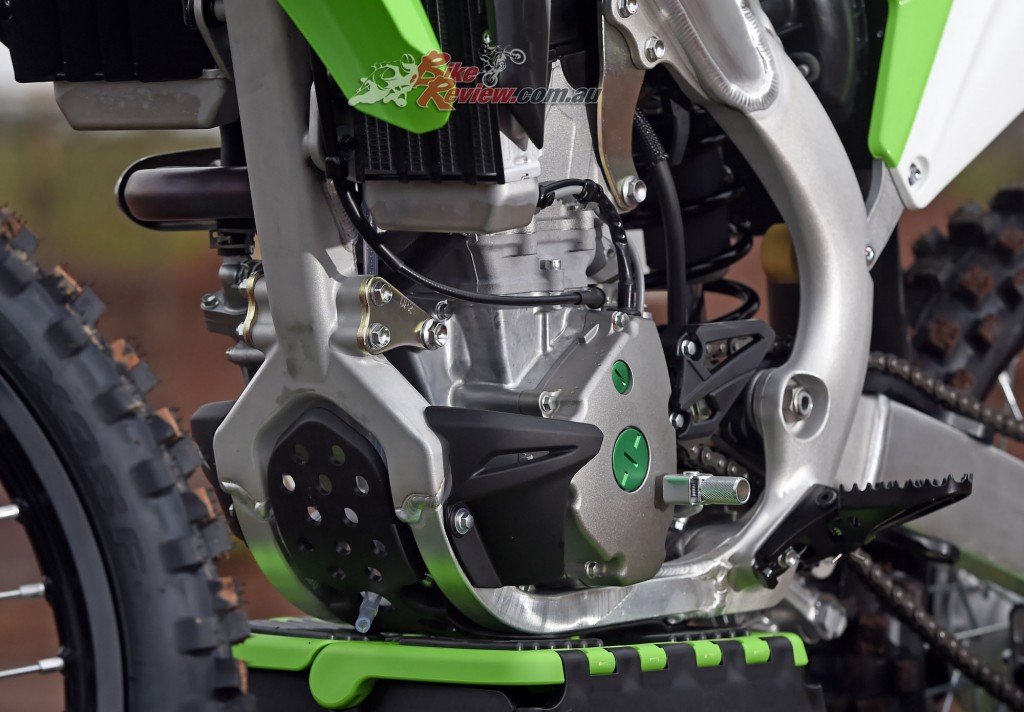 Frame design has been modified significantly from the previous model, the most noticeable changes are to the front down tube. Completely redesigned while also using different manufacturing methods and materials to achieve more front end feel.
Frame design has been modified significantly from the previous model, the most noticeable changes are to the front down tube. Completely redesigned while also using different manufacturing methods and materials to achieve more front end feel.
Overall weight has been reduced considerably to 104.5kg and while this only a year or two ago would have been amazing, still faces stiff competition.
Having built a completely new frame has allowed the 249cc engine to be tilted back some seven-degrees. The benefits are two fold, firstly this lets the bike turn quicker as there is less inertia from the crank and secondly the intake track is much straighter. This allows for better intake efficiency which in turn produces more power.
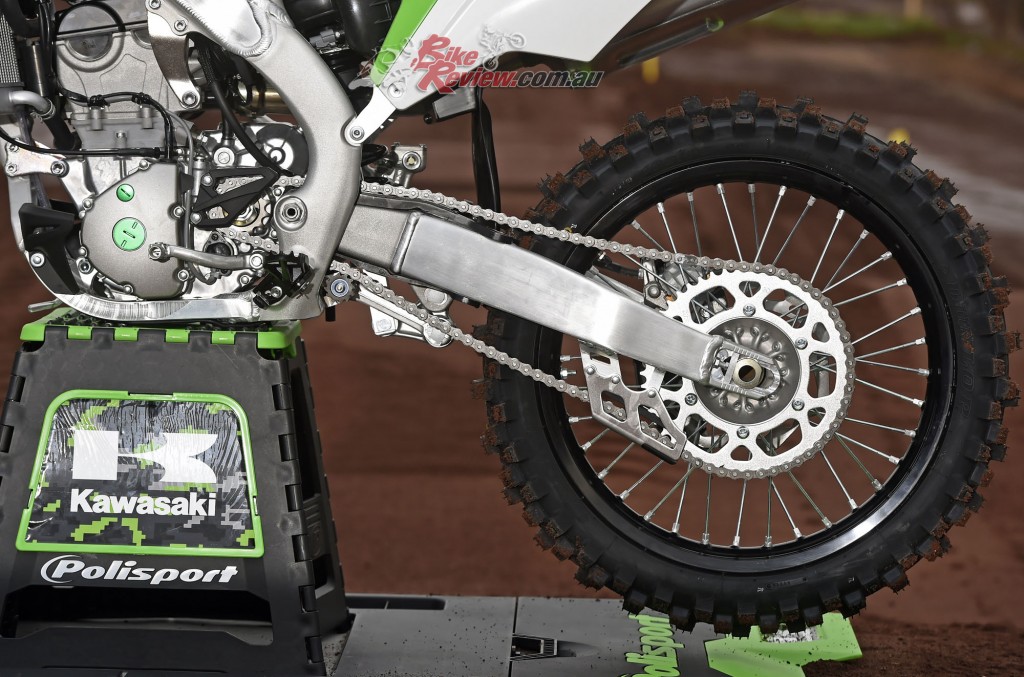 Swingarm design also got a massage, shaving off 190g and as this is unsprung weight there is also noticeable difference in rear suspension action over the previous model.
Swingarm design also got a massage, shaving off 190g and as this is unsprung weight there is also noticeable difference in rear suspension action over the previous model.
Braking is taken care of by Nissin brakes front and rear, these have been slightly changed from the previous years for a weight saving while the front end runs a floating disc for better braking feel.
As you would expect the KX250F runs Showa suspension both front and rear. What you may not realise is the forks are a high end Showa SFF Type2 setup with Titanium Nitride coating (black coating) on the fork legs. SFF is a Separate Function Fork meaning the spring preload is in the right fork leg and the damping is in the left fork leg.
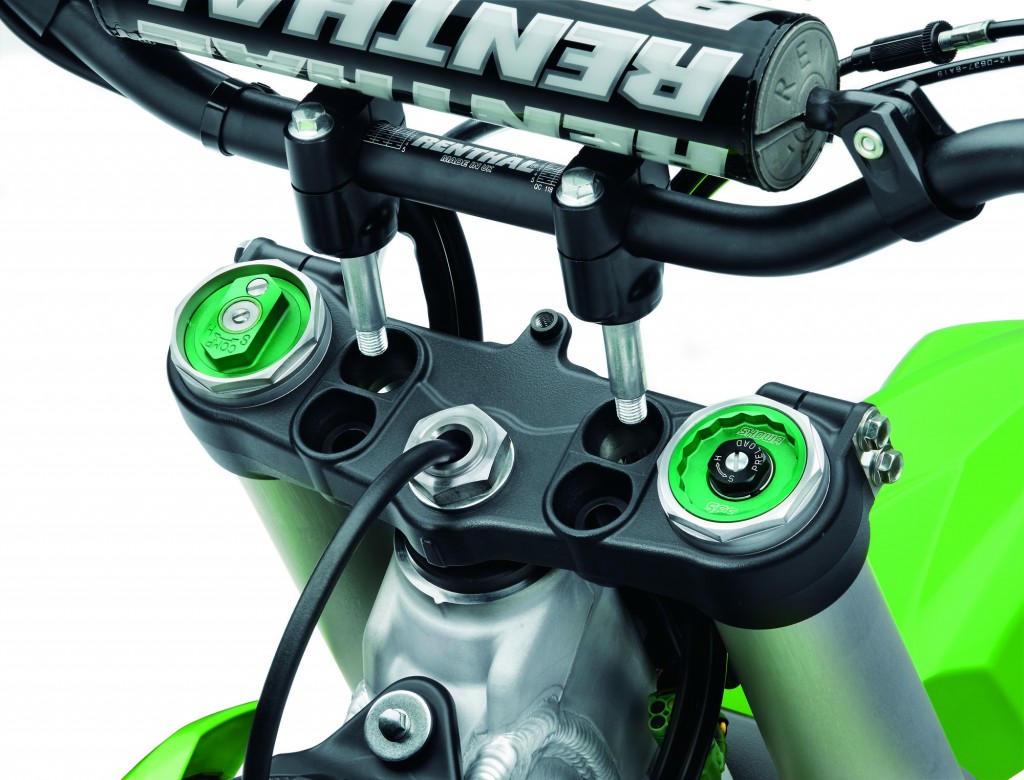 Previously Titanium Nitride coating as only available in the aftermarket world and was expensive to be had, while the benefits are less friction for a smoother travel and increased resistance to scratching the fork legs. To have this coating come standard on the Kawasaki is a big bonus and it looks cool to boot.
Previously Titanium Nitride coating as only available in the aftermarket world and was expensive to be had, while the benefits are less friction for a smoother travel and increased resistance to scratching the fork legs. To have this coating come standard on the Kawasaki is a big bonus and it looks cool to boot.
One of the other big advantages of this system over other standard forks is the adjustability and ease to make changes without disassembly. Preload changes can be made via a simple clicker adjuster on top, easy.
For 2017 Kawasaki have increased the spring rate in the forks and made valving changes to suit. This has the effect of keeping the front higher in the stroke and a more balanced feel between front to rear. The rear spring rate has been softened for the same reason.
The rear Showa shock has valving changes to suit the new chassis as well as running a lighter spring, with this alone saving 285g and achieved by using thinner gauge wire and also reducing the overall spring length.
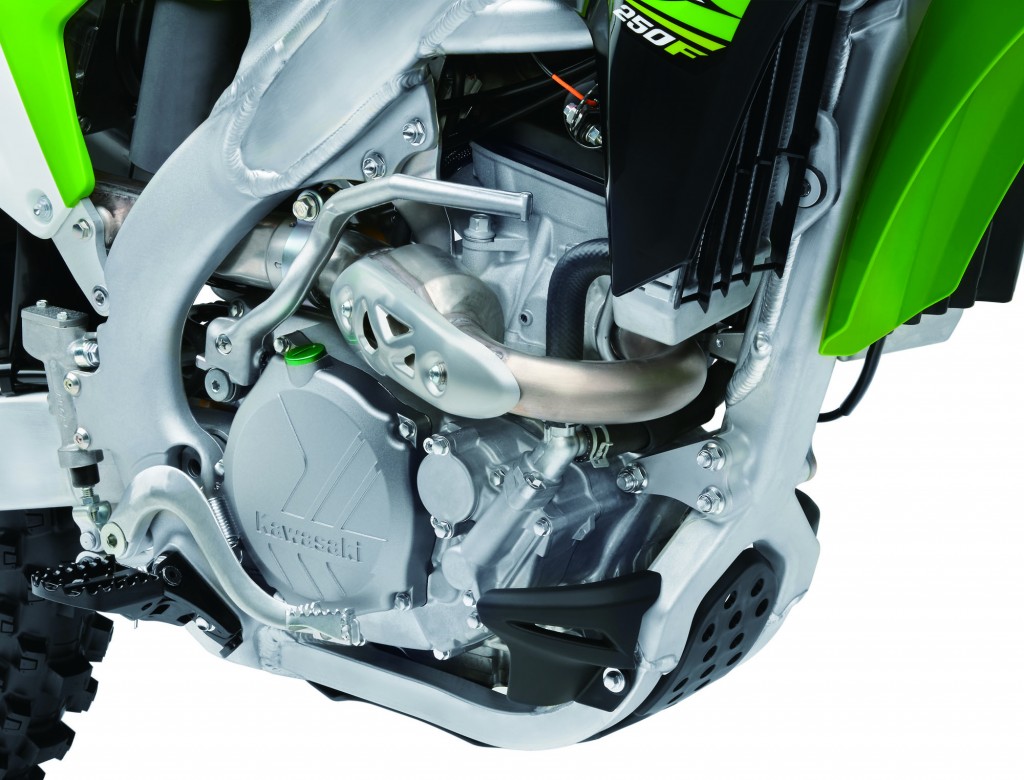 As already mentioned the new 249cc four-stroke engine has been tilted back in the frame seven-degrees. This has allowed more efficient cylinder filling and the bottom line is more fuel and air equals more power. The change from last year is substantial too, not just a couple of degrees but a huge 13-degree difference.
As already mentioned the new 249cc four-stroke engine has been tilted back in the frame seven-degrees. This has allowed more efficient cylinder filling and the bottom line is more fuel and air equals more power. The change from last year is substantial too, not just a couple of degrees but a huge 13-degree difference.
The continued used of dual injectors allows for crisp throttle response with the injector closest to the throttle body doing the low speed work while the injector located further up the in-take tract takes over in the higher gears. As the second injector is located further away from the combustion chamber the fuel atomises better, producing a better fuel mixture for a more complete burn at high rpm.
The injector closest to the combustion chamber has also been changed from a four-hole to an eight-hole injector, again promoting better combustion.
A little fact that I thought is of interest is that the KX250F injectors flow approximately 20 per cent more fuel than the injectors in the KX450F, due to the high rpm the 250 can run at.
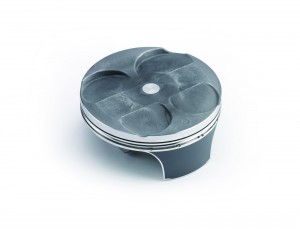 Kawasaki’s KX250F has a box type piston, which means these pistons have very short skirts, reducing weight and giving the motor the ability to rev out much quicker. The piston coating has been changed to molybdenum for increase wear resistance. Above the pistons are four titanium valves. Inlet valves are large 31mm items while exhaust valves are 25mm in diameter.
Kawasaki’s KX250F has a box type piston, which means these pistons have very short skirts, reducing weight and giving the motor the ability to rev out much quicker. The piston coating has been changed to molybdenum for increase wear resistance. Above the pistons are four titanium valves. Inlet valves are large 31mm items while exhaust valves are 25mm in diameter.
Another feature that has been carried over from 2016 but in my opinion is worth noting is the Launch Control Mode. Pressing and holding the launch control button on the left handlebar for two seconds initiates this mode, which is also confirmed by an orange flashing light. There is an absolute advantage to using this on a slick or muddy track. The system automatically switches off once third gear is selected.
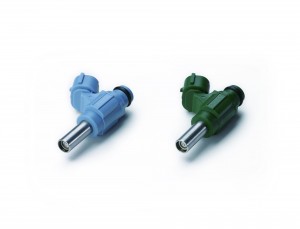 Another easy to use electronic feature also carried on from the 2016 KX250 are the three supplied FI Couplers, colour coded in White – Soft Terrain, Green – Standard and Black – Hard Terrain. These couplers require nothing more than unplugging one and plugging in another to suit the track conditions, and work by changing the mapping, making the power softer or harder hitting.
Another easy to use electronic feature also carried on from the 2016 KX250 are the three supplied FI Couplers, colour coded in White – Soft Terrain, Green – Standard and Black – Hard Terrain. These couplers require nothing more than unplugging one and plugging in another to suit the track conditions, and work by changing the mapping, making the power softer or harder hitting.
Stepping up from the FI Couplers if you really like full control is the optional FI Calibration Kit. This give complete access to both fueling and ignition maps. Standard there are seven preloaded maps included or you can tune to your own specs. The Calibration kit also doubles as a dashboard while the bike is running, giving you the current engine stats.
Something that I have not seen before as a manufacturer option is either increased or decreased flywheel weight. My personal preference would be for increased weight, especially for slick tracks.
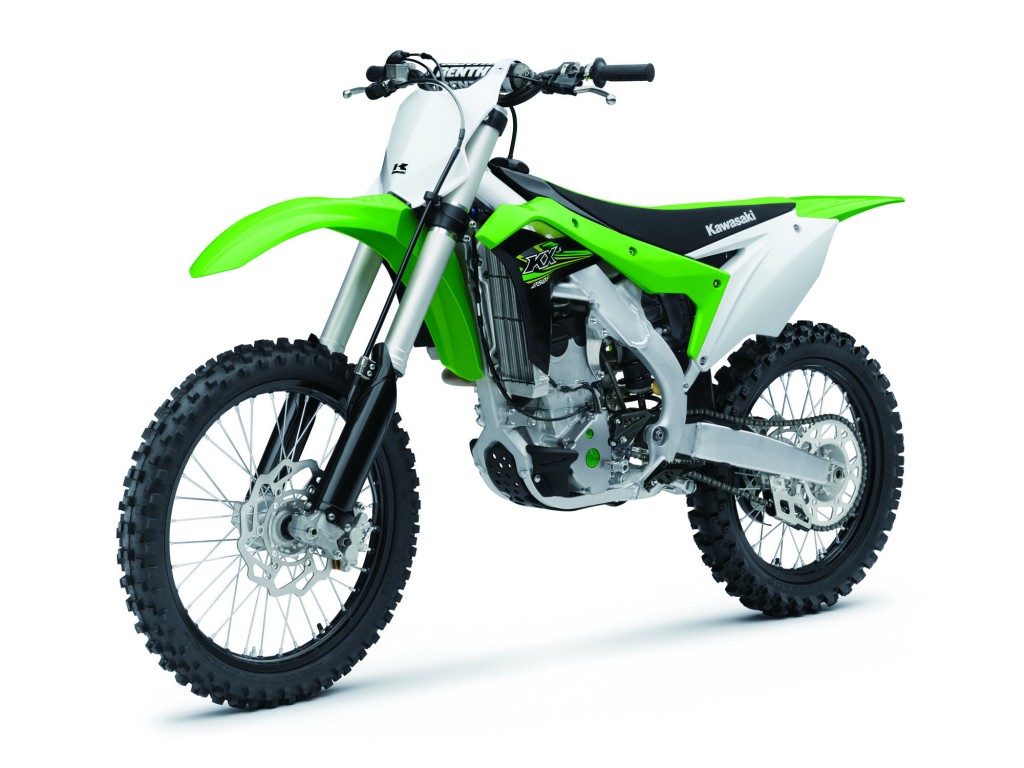
SPECIFICATIONS: 2017 Kawasaki KX250F
Price: : $10,499 RRP
Colours: Lime Green with factory-style graphics
Claimed power: N/A
Claimed torque: N/A
Wet weight: 104.5kg
Fuel capacity: 6.4L
Engine:Liquid-cooled, four-stroke single-cylinder, 249cc, 77 x 53.6mm bore x stroke, 13.7:1 compression, DOHC, four-valve, 43mm Keihin dual injection, Digital DC-CDI ignition
Gearbox: Five-speed
Clutch: Wet multi-disc
Chassis: Perimeter aluminium frame, Rake: 28.5°, Trail: 126mm
Suspension: 48mm USD Separate Function Forks (SFF) Type 2, 22-way compression damping, 20-way rebound damping, 40-way spring preload, Uni-Trak rear shock, 19-way (low-speed), four-turns (high-speed) compression damping, 22-way rebound damping, fully adjustable spring preload
Brakes: Single semi-floating 270mm petal disc, dual piston caliper, Single 240mm rear petal disc, single-piston caliper
Wheels & Tyres: Spoked wheels, 80/100-21 51M, 100/90-19 57M
Dimensions:
Wheelbase: 1475mm
Seat height: 940mm
Overall height: 1265mm
Overall width: 820mm


